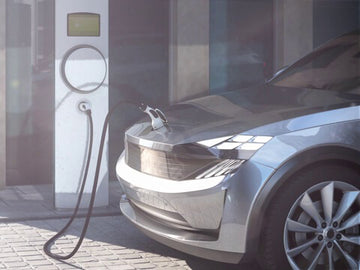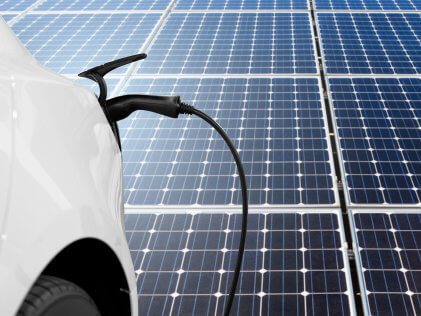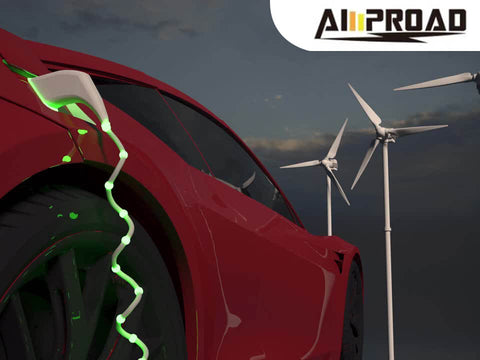
Electric vehicles are surging in popularity due to their environmental benefits and lower running costs. However, this clean driving revolution faces a roadblock: a lack of charging stations. Unlike the dense network of gas stations blanketing most areas, finding a place to top up your electric car can be a challenge, especially on long trips. This scarcity creates "range anxiety" for EV drivers, worried about running out of power before finding a charge. To truly unlock the potential of EVs, a robust and convenient charging infrastructure is crucial.
Demand Outpacing Infrastructure Development
Rapid Growth of EVs
The adoption of electric vehicles (EVs) has surged in recent years, fueled by heightened environmental awareness and the appeal of lower operating costs. As a result, sales of electric cars have witnessed a significant uptick, outpacing the growth rate of traditional gasoline vehicles. This trend underscores a fundamental shift in consumer preferences towards more sustainable transportation options.
Limited Charging Station Network
Despite the rapid growth of EVs, the development of charging infrastructure has struggled to keep pace with rising demand. This discrepancy is particularly evident in the disparity between the number of traditional gas stations and the availability of EV charging stations. While urban areas may boast a relatively dense network of charging stations, rural regions often face a dearth of charging options, posing challenges for EV owners in those areas. Consequently, the limited accessibility of charging infrastructure outside of urban centers can deter potential EV buyers and hinder the widespread adoption of electric vehicles.
Addressing the imbalance in charging station deployment is crucial for accommodating the growing EV market and promoting broader adoption. Initiatives aimed at expanding the EV charging network, particularly in underserved rural areas, are essential for ensuring equitable access to charging infrastructure. Moreover, strategic partnerships between public and private stakeholders, along with government incentives and investment, can play a pivotal role in accelerating the development of EV charging infrastructure nationwide. By bridging the gap between EV demand and charging infrastructure availability, stakeholders can facilitate the transition to electric mobility and pave the way for a more sustainable transportation future.
Economic and Logistical Challenges
High Cost of Setting Up Charging Stations
Establishing charging stations incurs substantial costs encompassing equipment procurement, installation, and potential upgrades to the electricity grid. These expenses pose significant financial barriers for prospective station operators, particularly in the absence of clear visibility into long-term profitability. While the demand for EV charging infrastructure continues to grow, uncertainty regarding the viability and sustainability of charging stations can dampen investor confidence and deter potential stakeholders from entering the market. Additionally, the high upfront costs associated with installing charging stations may necessitate collaboration between public and private entities to mitigate financial risks and facilitate infrastructure development.
Complexities in Infrastructure Planning
Infrastructure planning for EV charging stations is fraught with complexities, ranging from navigating permitting processes to complying with regulations at the local, state, and federal levels. Delays in obtaining necessary permits can prolong the rollout of charging infrastructure, hampering efforts to meet growing demand for EV charging services. Moreover, upgrading the electricity grid to accommodate the increased demand from charging stations presents logistical challenges and requires significant time and investment. Coordinating with utility providers and local authorities to address grid capacity constraints and ensure reliable power supply to charging stations is essential for overcoming these logistical hurdles.
In addressing economic and logistical challenges, innovative solutions and strategic partnerships are essential for advancing EV charging infrastructure. Collaboration between public and private sectors can leverage resources and expertise to accelerate infrastructure deployment while minimizing costs and regulatory hurdles. Furthermore, technological advancements such as smart charging solutions and grid integration tools can enhance the efficiency and sustainability of charging infrastructure. By overcoming economic barriers, streamlining infrastructure planning processes, and embracing innovative solutions, stakeholders can drive the expansion of EV charging infrastructure and support the widespread adoption of electric vehicles. Mentioning the Tesla destination charger, a prominent player in the charging infrastructure market, illustrates the diversity of charging options available and underscores the importance of industry collaboration in addressing these challenges.
Lack of Standardization and User Experience Issues
Navigating the landscape of electric vehicle (EV) charging infrastructure presents challenges stemming from the lack of standardization and varying user experiences. Here's a closer look at the key issues:
Incompatibility Concerns
The proliferation of different charging standards and connector variations contributes to compatibility concerns for EV owners. While Level 2 EV charger is prevalent in many charging networks, the presence of DC Fast Chargers adds another layer of complexity. Furthermore, variations in connector types, such as Tesla's proprietary connector versus the CCS standard, exacerbate compatibility issues. EV owners may encounter difficulties when attempting to charge their vehicles at stations equipped with incompatible connectors, limiting their charging options and potentially causing frustration. Additionally, some EV models may face challenges utilizing all available charging stations due to connector incompatibility, further highlighting the need for standardization efforts within the industry.
Inconsistent Pricing and Payment Methods
The lack of standardized pricing structures for EV charging across different networks adds to the complexity of the user experience. EV owners often find themselves managing multiple accounts and payment methods for various charging providers, leading to inconvenience and inefficiency. The absence of uniformity in pricing models complicates cost calculations and makes it challenging for consumers to compare charging costs across different networks. Streamlining pricing structures and payment methods would enhance transparency and convenience for EV owners, encouraging greater adoption of electric vehicles and utilization of charging infrastructure.
Availability and Functionality Concerns
Accessing charging stations during peak hours can be challenging due to limited availability, leading to long waiting times and inconvenience for EV owners. Additionally, the functionality of charging stations is a significant consideration, as out-of-order stations or unreliable network connections can disrupt charging attempts. Reliability issues detract from the user experience and undermine confidence in the reliability of charging infrastructure. Addressing availability concerns and ensuring the functionality of charging stations is essential for promoting EV adoption and enhancing the overall user experience. By addressing these standardization and user experience issues, stakeholders can foster a more seamless and accessible EV charging ecosystem, driving the transition towards sustainable transportation.
Potential Solutions
Addressing the challenges of EV charging infrastructure requires collaborative efforts and strategic initiatives. Here are some potential solutions:
Government Incentives and Policy Initiatives
Governments can play a pivotal role in incentivizing the development of EV charging infrastructure through public funding and tax breaks. By providing financial support and regulatory incentives, policymakers can encourage private investment in charging station deployment. Streamlining permitting processes and regulations can also expedite the approval and construction of charging stations, reducing barriers to entry for station operators. Additionally, policymakers can implement policies that promote the adoption of EVs, such as zero-emission vehicle mandates and emissions regulations, further driving demand for charging infrastructure.
Collaboration Between Stakeholders
Collaboration among key stakeholders, including utilities, automakers, and charging companies, is essential for developing standardized solutions and advancing the EV charging ecosystem. By working together, stakeholders can coordinate efforts to establish interoperable charging standards and protocols, facilitating seamless integration between different charging networks. Investment in innovative charging technologies, such as wireless charging and fast-charging solutions, can enhance the efficiency and convenience of EV charging. Furthermore, grid modernization initiatives can improve the reliability and capacity of electricity networks to accommodate the growing demand from EV charging.
Consumer Education and Awareness
Educating consumers about EV charging options, etiquette, and available resources is crucial for promoting wider adoption of electric vehicles. Providing information about different types of chargers, charging speeds, and charging network coverage can empower consumers to make informed decisions about EV ownership. Building a stronger sense of community among EV owners through online forums, social media groups, and local meetups can foster knowledge sharing and support networks. Additionally, raising awareness about the environmental and economic benefits of EVs can encourage more individuals to transition to electric transportation, driving demand for charging infrastructure.
By implementing these potential solutions in tandem, governments, stakeholders, and consumers can collaboratively address the challenges facing EV charging infrastructure and accelerate the transition to sustainable transportation.
FAQs / People Also Ask
Q1: How do I find nearby EV charging stations?
A1: Several online platforms and mobile apps provide real-time information about nearby EV charging stations. These platforms allow users to search for stations based on location, charger type, availability, and more.
Q2: How long does it take to charge an electric vehicle?
A2: Charging times vary depending on factors such as the vehicle's battery size, charger type, and the state of charge. Generally, Level 1 chargers (standard household outlets) provide slower charging rates, while Level 2 chargers and DC Fast Chargers offer faster charging options.
Q3: Can I use any EV charger for my electric vehicle?
A3: EV charger comes in different types and connector standards, so it's essential to ensure compatibility between your vehicle and the charger. Most electric vehicles can use Level 1 and Level 2 charger, but some may require adapters or specialized connectors for compatibility with certain charging networks.
Q4: Can I charge my electric vehicle at home?
A4: Yes, many electric vehicle owners charge their vehicles at home using Level 1 or Level 2 chargers. Level 1 chargers can be plugged into standard household outlets, while Level 2 chargers require installation of a dedicated charging station. Home charging offers convenience and flexibility, allowing EV owners to top up their vehicle's battery overnight or whenever convenient. Products like the AMPROAD level 1 & level 2 dual use portable EV charger provide added convenience for both home and travel charging needs.
Q5: How much does it cost to charge an electric vehicle?
A5: Charging costs vary depending on factors such as electricity rates, charger type, and the vehicle's battery size. Some charging stations offer free or discounted charging, while others may require payment based on usage or subscription fees. It's advisable to check charging rates and payment methods before using a charging station.







